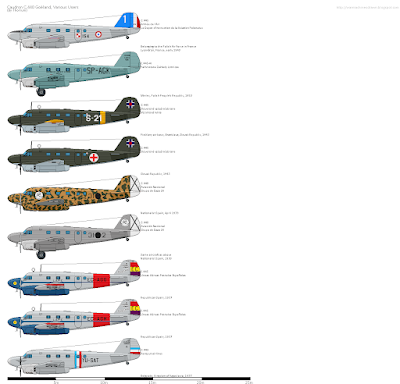The Caudron C.440 Goéland (French word for "Seagull") was a French six-seat twin-engined utility aircraft of the 1930s that saw service with many foreign users:
- Poland: The Caudron C.445 was used by the Polish Air Force in France in 1940 as a bomber pilot and navigator trainer. They were employed in the flying schools of Lyon-Bron, Clermont-Ferrand, Istres, Corbas, Rennes and St. Cyr. From 13th May 1940 until the end of the Battle of France, the Franco-Polish Goélands were used as utility and transport airplanes to transport both men and materiel to and from frontlines. Later, during the French retreat, they were employed to evacuate Polish transport personnel. In fact, on 23rd June two Goélands evacuated a group of 16 Polish pilots from Perpignan to Oran, in Algeria.
At the end of the war, one C.445A-T that was built in France during the German occupation, was captured by the Poles at the city of Dziwnów, in a very bad condition though. In spite of initial interests by the Polish Air Force for the plane, it was transferred to civilian aviation, where PZL-Mielec rebuilt it and used it for transport duties and company business trips. Oddly enough, the production license and technical documentation for the PZL-Mielec Lim-1 (the Polish MiG-15 license-built in Poland) was transported in this airplane. It was used by PZL from 22nd August 1947 until 12th September 1955. - Slovak Republic: Twelve C.445M (military variant of the regular C.445) were ordered by the Slovenské Vzdusné Zbrane (Slovak Air Force) in 1942 (although, according to other sources they were transferred by the Luftwaffe from captured machines). They were employed in the trainer and transport role, and their ultimate fate is unknown.
- Spain: After the outbreak of the Spanish Civil War, the Republican Spanish Líneas Aéreas Postales Españolas (Spanish Postal Airlines - LAPE) acquired three ex-French Goéland machines. They were employed in various aerial routes inside the Republican territory during the Spanish Civil War. All three of them were either destroyed or captured by the Nationalists. After the war, in May 1940 some fleeing machines crash-landed in Spain and their crew and machines were interned.
- Yugoslavia: The Yugoslavian National Airline Aeroput, bought two C.449 monoplanes in 1937 and 1938 as part of their modernization programme in order to cover more aerial routes. One of them was damaged beyond repair in 1939 and the other one was pressed into service with the Royal Yugoslav Air Force in 1941 when Germany invaded and was subsequently captured by them in April 1941.
Sources:
1. https://en.wikipedia.org/wiki/Caudron_C.440_Goéland
2. http://www.samolotypolskie.pl/samoloty/638/126/Caudron-C-445-Goeland (translated)
3. https://en.wikipedia.org/wiki/Aeroput
4. http://equinoxe.dk/SCWaircraft/did.html
5. http://incidentessgm.blogspot.com/2013/11/caudron-c-445.html (translated)
6. http://www.airhistory.org.uk/gy/reg_YU-.html
7. http://www.airhistory.org.uk/gy/reg_EC-.html










